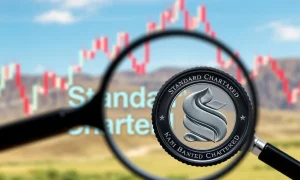Financial markets often react sharply to unexpected economic data. Therefore, when the July PPI inflation reading arrived, it blindsided many investors. This crucial Producer Price Index data suggested stronger inflationary pressures than anticipated. Consequently, many expected a significant downturn in stock values. However, the stock market largely shrugged off this seemingly hot report. This raises an important question: did stocks truly ignore the warning signs, or was a deeper impact simply delayed?
Understanding PPI Inflation: A Key Economic Indicator
To begin, let’s clarify what PPI inflation actually represents. The Producer Price Index (PPI) measures the average change over time in the selling prices received by domestic producers. These prices are for their output. In essence, PPI tracks inflation from the perspective of the seller. It is often seen as a leading indicator of consumer inflation (CPI).
Why is PPI so important? Consider these points:
- Input Costs: PPI reflects the costs businesses incur for goods and services.
- Pass-Through: Rising producer prices often get passed on to consumers. This can lead to higher consumer prices.
- Profit Margins: High PPI can squeeze corporate profit margins if companies cannot raise their own prices.
- Monetary Policy: Central banks closely monitor PPI. It helps them gauge inflationary trends and inform monetary policy decisions.
Therefore, a surprisingly high PPI reading typically signals future inflationary risks. This can prompt central banks to consider more aggressive tightening measures. Such measures often include interest rate hikes. These hikes can dampen economic growth and negatively impact stock valuations.
The Hot July PPI Inflation Reading: What Happened?
The July PPI inflation report indeed delivered a surprise. Economists had largely expected a more modest increase. Instead, the data showed a stronger-than-anticipated rise in producer prices. This indicated persistent inflationary pressures within the economy. For instance, the headline PPI increased more than consensus estimates. Core PPI, which excludes volatile food and energy components, also rose unexpectedly. These figures caught many market participants off guard.
The key takeaways from the July report included:
- Unexpected Surge: Both headline and core PPI exceeded forecasts.
- Services Sector Strength: Price increases in the services sector contributed significantly. This suggested broad-based inflation.
- Energy Price Rebound: A rebound in energy prices also played a role. This added to the overall inflationary picture.
Such a strong reading typically triggers concerns about the Federal Reserve’s next moves. Investors often fear that the Fed will respond with further interest rate hikes. Higher rates can increase borrowing costs for businesses and consumers alike. This can slow down economic activity and reduce corporate earnings, potentially hurting stock prices.
Investor Expectations Versus Market Reality
Given the hot PPI inflation data, many investors braced for a negative market reaction. Historically, unexpected inflation surges have often led to sell-offs in equities. This is because inflation erodes purchasing power. It also increases the likelihood of tighter monetary policy. However, the stock market’s initial response was remarkably subdued. Major indices, including the S&P 500 and Nasdaq Composite, showed resilience. They either ended the day relatively flat or even posted modest gains.
This market behavior puzzled many analysts. Typically, a strong inflation report implies a more hawkish Fed. A hawkish Fed generally means higher interest rates for longer. This scenario is usually bearish for growth stocks and the broader market. Therefore, the market’s apparent shrug seemed counterintuitive. Investors often prioritize future earnings potential. High inflation and rising rates can significantly dampen this potential. So, why did the market not react more negatively?
Why Stocks Seemingly Shrugged Off the Hot PPI Inflation
Several factors might explain the stock market’s muted reaction to the hot July PPI inflation report. First, some market participants may have already priced in a certain level of inflation. They anticipated some upward pressure. This means the actual numbers, while higher than expected, did not represent a complete shock. Secondly, investors might have focused on other economic indicators. These indicators might have painted a more optimistic picture. For example, some may have seen signs of a resilient economy. This resilience could potentially absorb higher prices.
Furthermore, earnings season was in full swing during this period. Strong corporate earnings reports from major companies could have offset inflation concerns. Positive earnings often provide a fundamental boost to stock prices. This can overshadow macroeconomic worries. Additionally, some analysts suggested that the market might be looking past short-term inflation spikes. They might be focusing on the longer-term disinflationary trend. This trend is driven by supply chain improvements and moderating demand. Finally, technical factors or specific sector rotations could have played a role. For example, certain defensive sectors might have performed well. This could have masked underlying weaknesses in other areas.
Here are some potential reasons for the muted reaction:
- Prior Pricing: Some inflation was already factored into valuations.
- Focus on Earnings: Strong corporate profits provided a counterbalance.
- Economic Resilience: Belief in the economy’s ability to handle higher costs.
- Disinflationary Hopes: Long-term optimism about inflation moderating.
- Sector-Specific Dynamics: Certain sectors performing well, offsetting others.
The Nuance: Was it a True Shrug, or a Delayed Reaction to PPI Inflation?
While the initial reaction to the July PPI inflation data appeared subdued, a deeper look reveals more nuance. A market’s initial response does not always tell the whole story. Sometimes, the full implications of economic data unfold over days or even weeks. Investors might take time to digest complex information. They also need to adjust their portfolios accordingly. Therefore, the apparent shrug could have been a temporary phenomenon. It might mask underlying concerns that could surface later.
Consider these possibilities:
- Delayed Reassessment: Investors might have needed more time. They could be reassessing their inflation outlook.
- Sectoral Divergence: While major indices held up, specific sectors might have seen significant shifts. For instance, growth stocks might have underperformed. Value stocks or defensive sectors might have shown more resilience.
- Bond Market Signal: The bond market often reacts differently. Bond yields might have risen, signaling increased inflation expectations. This could foreshadow future stock market pressure.
- Volatility Spike: Even if indices remained flat, intraday volatility might have increased. This indicates underlying investor uncertainty.
It is crucial to monitor subsequent market movements. This includes looking at bond yields, sector performance, and volatility metrics. These can provide a more complete picture of how the market truly digested the hot PPI report. The immediate lack of a strong negative reaction does not necessarily mean the market is immune to inflation risks.
Implications for Inflation Outlook and Fed Policy
The hot July PPI inflation reading undoubtedly complicates the inflation outlook. It adds another layer of complexity to the Federal Reserve’s policy decisions. The Fed has been aggressively raising interest rates to combat inflation. They aim to bring it down to their 2% target. A strong PPI report suggests that inflationary pressures remain persistent. This could force the Fed to maintain a hawkish stance for longer. It might even prompt further rate hikes.
Conversely, some argue that one strong data point does not define the entire trend. They suggest that other indicators might still point towards disinflation. The Fed’s decisions will depend on a holistic view of economic data. This includes CPI, employment figures, and wage growth. However, the PPI report certainly strengthens the argument for continued vigilance against inflation. Investors will closely watch upcoming Fed meetings. They will also scrutinize any statements from Fed officials. These will provide clues about the future path of interest rates. The interplay between inflation data and monetary policy remains a critical driver for market performance.
Expert Analysis and Future Projections Regarding PPI Inflation
Financial analysts and economists have offered varied interpretations of the July PPI inflation data. Some experts view it as a clear signal. They believe inflation remains sticky and challenging to bring down. They anticipate that the Federal Reserve will likely need to implement more restrictive policies. This could involve additional rate hikes or maintaining high rates for an extended period. This perspective often emphasizes the strength in the services sector prices. It also highlights the rebound in energy costs. These factors suggest broad-based inflationary pressures.
However, other analysts adopt a more cautious approach. They argue that one month’s data does not establish a new trend. They point to the overall downward trajectory of inflation from its peak. They suggest that supply chain improvements continue to exert disinflationary pressure. They also note that consumer demand might be moderating. This could eventually alleviate price pressures. These experts might advocate for the Fed to adopt a wait-and-see approach. They believe that the full impact of past rate hikes has yet to be seen. Consequently, future projections for inflation and interest rates remain diverse. Investors must consider multiple viewpoints when making decisions.
Strategies for Investors in an Uncertain Environment
The unexpected July PPI inflation reading highlights the need for adaptable investment strategies. In an environment where inflation surprises can occur, diversification becomes paramount. Investors should consider a balanced portfolio. This includes a mix of equities, fixed income, and potentially inflation-hedging assets. For instance, certain sectors may perform better during inflationary periods. These include energy, materials, and financials. Companies with strong pricing power can also fare well. They can pass on higher costs to consumers without losing market share.
Conversely, growth stocks, which rely heavily on future earnings, can be more vulnerable. Their valuations are often more sensitive to rising interest rates. Fixed-income investments, like bonds, can also be negatively impacted by rising inflation. This is because inflation erodes the real value of fixed payments. Therefore, investors might explore shorter-duration bonds. They could also look into Treasury Inflation-Protected Securities (TIPS). These are designed to protect against inflation. Regularly reviewing and adjusting one’s portfolio based on evolving economic data is crucial. Staying informed about inflation trends and central bank policies is also vital for navigating these uncertain times.
Conclusion: Navigating the Complexities of PPI Inflation
The hot July PPI inflation reading indeed blindsided many investors. Yet, the stock market’s initial shrug raised more questions than answers. While the immediate reaction was muted, this does not necessarily dismiss the underlying inflationary pressures. Several factors likely contributed to the market’s resilience. These include prior pricing, strong corporate earnings, and hopes for long-term disinflation. However, the report undeniably adds complexity to the inflation outlook. It also impacts the Federal Reserve’s future policy decisions. Investors must remain vigilant. They should monitor subsequent economic data and central bank communications. Adapting investment strategies to account for persistent inflation risks is also essential. The economic landscape remains dynamic. Therefore, a nuanced understanding of indicators like PPI inflation is critical for informed decision-making.
Frequently Asked Questions (FAQs)
Q1: What is the Producer Price Index (PPI), and why is it important?
The Producer Price Index (PPI) measures the average change in selling prices received by domestic producers for their output. It is important because it indicates inflation from a producer’s perspective. It often acts as a leading indicator for consumer inflation (CPI). Rising PPI suggests businesses face higher costs. These costs can then be passed on to consumers.
Q2: How did the July PPI inflation reading surprise investors?
The July PPI inflation reading surprised investors because both the headline and core figures rose more than economists had predicted. This indicated stronger and more persistent inflationary pressures than the market had anticipated, especially from the services sector and a rebound in energy prices.
Q3: Why did the stock market seemingly shrug off the hot PPI inflation report?
The stock market’s muted reaction could be due to several factors. These include some inflation already being priced in, strong corporate earnings reports providing a counterbalance, and a belief in the economy’s resilience. Additionally, investors might be looking past short-term spikes, focusing on long-term disinflationary trends.
Q4: Does the stock market’s initial reaction tell the whole story about PPI inflation impact?
No, the initial reaction does not always tell the whole story. The full implications of economic data can unfold over time. A seemingly subdued initial response might mask underlying concerns that surface later. It is important to monitor subsequent market movements, including bond yields and sector performance, for a more complete picture.
Q5: What are the implications of the July PPI reading for Federal Reserve policy?
The July PPI reading strengthens the argument for continued vigilance against inflation. It suggests that inflationary pressures remain persistent. This could prompt the Federal Reserve to maintain a hawkish stance for longer. It might even lead to further interest rate hikes, depending on other incoming economic data.
Q6: How can investors adapt their strategies in response to unexpected PPI inflation data?
Investors can adapt by diversifying their portfolios across various asset classes. They should consider sectors that perform well during inflation, such as energy and materials. Companies with strong pricing power are also good options. They might also explore inflation-protected securities like TIPS. Regularly reviewing and adjusting portfolios based on evolving economic data is crucial.
























